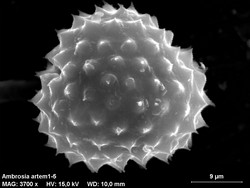Changing environment helps spread allergenic pollen
Common ragweed is continuing to spread, resulting in significant negative impacts on the European economy through its effect on health, agriculture, biodiversity and even tourism. The EU-funded ATOPICA (Atopic diseases in changing climate, land use and air quality) project was therefore established to investigate how continued migration of this invasive plant species coupled with climate change can affect ragweed pollen levels across Europe. Scientists produced computer simulations for concentrations of common ragweed as well as air pollutants for the years 1991-2010 and two future periods (2021-2040 and 2041-2060). The models developed for ragweed distribution were coupled and tested with a plant life-cycle model, a vegetation model (Orchidee) and two dispersion models (RegCM and Chimere). These modelled current and future ragweed pollen levels were used to estimate consequences for allergy sensitisation across Europe. Researchers also studied vulnerable groups of allergic patients in Germany and Croatia, conducting skin prick tests on elderly subjects and children to examine current levels of ragweed sensitisation. Blood samples were collected to allow serological testing as well as DNA and RNA studies. Results suggest a higher sensitisation in the age group 60-69 years, with men appearing more often sensitised than women. Observational studies in Croatia were conducted involving children from areas subject to low, intermediate and high levels of exposure to both airborne common ragweed pollen and air pollution. Analysis of sensitisation in 2 age groups (4-6 and 7-10 years) revealed higher prevalence of ragweed sensitisation in the older age group for all 3 regions. Sensitisation was more prevalent in males and the highest number of sensitised children was found in Zagreb and surrounding area. This region has medium concentrations of ragweed pollen but high levels of air pollution corresponding to a highly urbanised area of a capital city. In addition, the consortium examined the allergenic potential of commercially available pollen and pollen collected from rural and urban areas by administering to the nasal passages of mice. Researchers then evaluated allergic responses and observed that there were significant differences in the intensity of allergic responses induced by different pollen populations. This suggests that the environment may enhance the severity of allergy in patients. ATOPICA increased understanding of the multiple environmental factors and stressors influencing allergic disease and developed quantitative scenarios of allergic disease risk for the present and in the future. These scenarios will increase awareness of the risks leading to allergy in response to the environment, and provide guidance for combating common ragweed.
Keywords
Allergenic, pollen, common ragweed, atopic, invasive plant species, allergy







